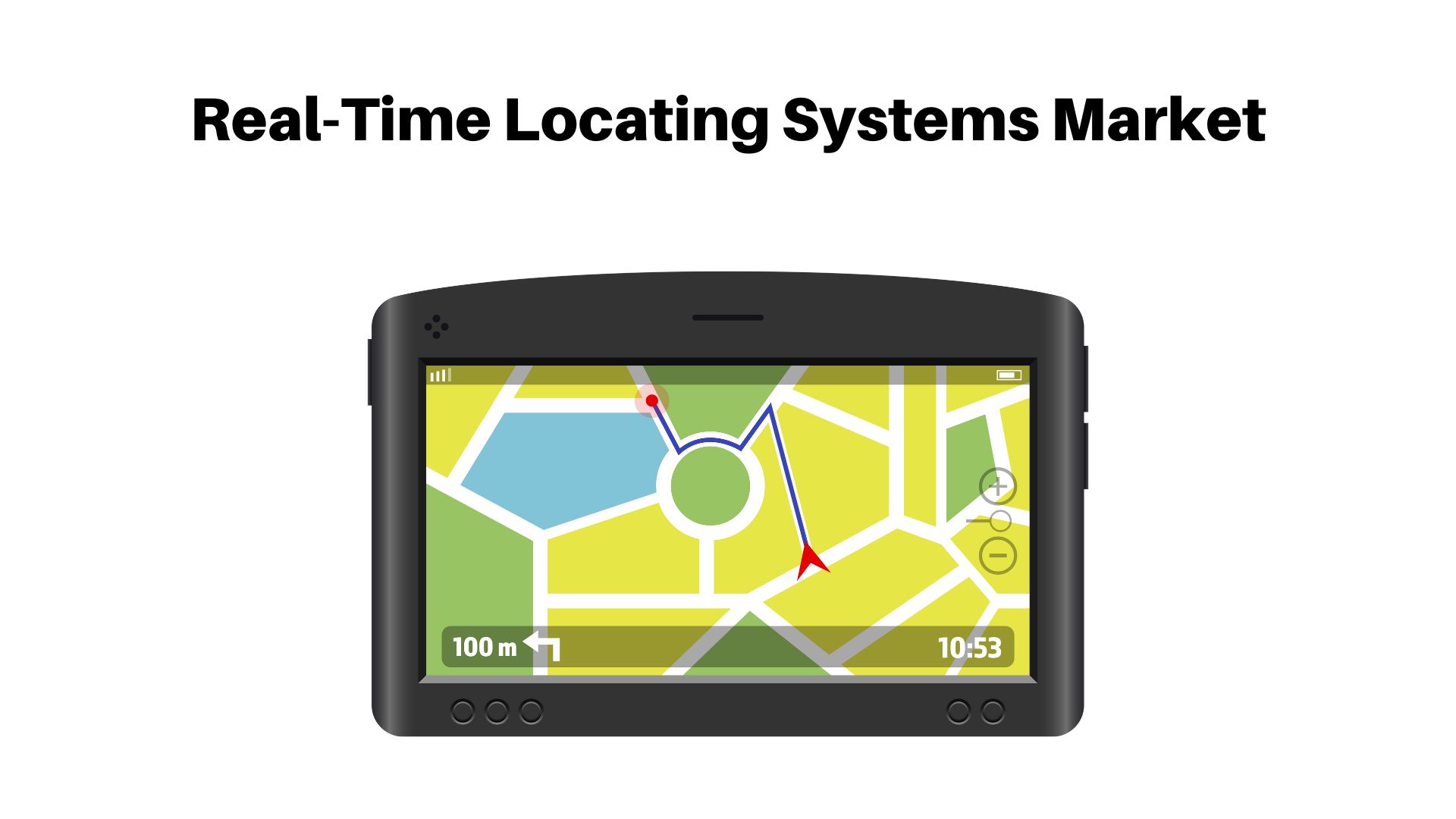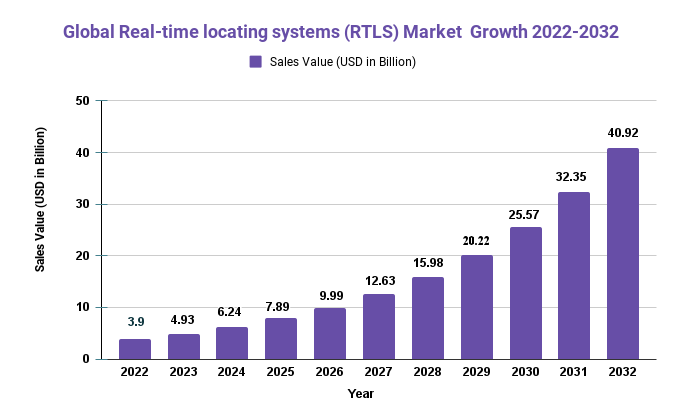Real-Time Locating Systems (RTLS) Market Size will Observe Substantial Growth by 2032 with a CAGR of 26.50%

Page Contents
Market Overview
Real-time locating systems (RTLSs) enable real-time tracking and location of assets or people through various technologies like RFID, GPS, Wi-Fi, and UWB. The RTLS market is expected to experience substantial growth due to their increasing adoption across various end-use industries such as healthcare, retail, transportation, and logistics.
Global Real-Time Locating Systems Market size is expected to reach USD 51.77 Bn by 2032 from USD 3.90 Bn in 2022, increasing at a compound annual growth rate (CAGR) of 26.50% between 2023 and 2032.
The market is driven by factors such as the growing need for asset tracking and management, improved supply chain visibility, and increasing adoption of RTLS in healthcare facilities to enhance patient safety and operational efficiency.
Drivers, trends, and challenges have an impact on market dynamics, which can impact businesses. Request for PDF sample report

Key Takeaways
- The global RTLS market is expected to reach USD 13.5 billion by 2028, growing at a compound annual growth rate (CAGR) of 26.50% from 2023-2032.
- Healthcare will remain the leading end-use industry for RTLS due to rising demands for patient tracking and safety solutions.
- RFID is the most widely utilized technology for RTLS, accounting for a considerable share of the market.
- North America dominates this space due to its rapid adoption of advanced technologies and the concentration of major players within the region.
- The market is highly competitive, featuring key players such as Zebra Technologies, Stanley Black & Decker, and Ubisense Group PLC.
Regional Snapshot
The global RTLS market is divided into North America, Europe, Asia-Pacific, Latin America, and Middle East & Africa. North America dominates the market due to the high adoption of advanced technologies and the presence of major players there. Asia-Pacific region is expected to experience significant growth during the forecast period due to the increasing adoption of RTLS across various end-use industries such as healthcare, retail, and manufacturing.
Driver
Rapid Transformational Labeling System Adoption in Various Industries: RFID technology is being increasingly adopted across healthcare, retail, manufacturing, and logistics to track assets, manage inventory and enhance operational efficiency.
Advancements in technology: The advent of ultra-wideband (UWB) and Bluetooth Low Energy (BLE) has enabled RTLS systems to achieve improved accuracy and dependability, making them increasingly attractive to businesses.
Rising Demand for Supply Chain Visibility: There is an increasing need for supply chain visibility and traceability, driving the adoption of Real-Time Latitude System (RTLS) technology to track assets and inventory in real-time, monitor shipment progress, and optimize supply chain operations.
An increasing emphasis on worker safety: Businesses are investing in RTLS technology to enhance worker protection by tracking employees in potentially hazardous environments or areas with heavy machinery.
Growing demand for automation and process optimization: RTLS technology can be utilized to automate various processes and optimize operations, leading to improved efficiency and lower costs.
Restraints
High Deployment and Operating Expenses: RTLS technology can be costly to deploy and operate, which could pose a barrier for some businesses – particularly smaller ones with limited budgets – who otherwise might find the benefits of the technology too great to ignore.
Privacy and Security Issues: RTLS technology raises privacy and security issues, particularly in industries such as healthcare where patient data must be safeguarded.
Limited Accuracy and Reliability in Certain Environments: RTLS technology may not perform as well in certain conditions, such as areas with high interference levels or metal structures, which could hinder its usefulness in some applications.
Limited Battery Life of Tags and Sensors: Unfortunately, the battery life of RTLS tags and sensors may be limited, necessitating frequent replacement or charging – adding to the cost of ownership for the system.
Limited Interoperability and Standardization: Due to a lack of standardization in the RTLS market, interoperability between different systems and technologies may be limited, making it challenging for businesses to integrate RTLS with other applications and systems.
Opportunities
Growing Demand for RTLS Technology in Emerging Economies: As businesses in developing nations become more digitalized and seek ways to enhance their operational efficiency, RTLS technology is seeing an expanding presence in these regions.
Expansion into New Applications and Industries: RTLS technology is not exclusive to one industry or application, providing vendors with a great opportunity to expand into other markets and applications like sports or entertainment.
Growth Opportunities in the Healthcare Sector: The healthcare industry is a major market for RTLS technology, with applications ranging from asset tracking and patient monitoring to staff safety. As demand for healthcare services continues to increase, there is an excellent opportunity for RTLS vendors to expand their presence within this space.
Challenges
Integration with Existing IT Infrastructure: Integrating RTLS technology into an existing IT infrastructure can be a complex process, particularly in larger organizations with legacy systems that may pose obstacles to adoption.
Regulatory Barriers: In certain applications, such as healthcare, the use of RTLS technology may be subject to regulatory requirements and compliance standards that could pose obstacles to adoption.
Scalability and Interoperability: RTLS systems must be capable of scaling and interoperating to meet the demands of various organizations and industries, as well as to integrate with other systems and applications.
Cost Effectiveness: Deploying and maintaining RTLS systems can be expensive for some organizations, especially smaller ones with tight budgets.
Grow your profit margin with Market.us – Acquire this Report
Recent Developments
- In January 2021, Zebra Technologies unveiled its Ultra Wideband (UWB) RTLS solutions for asset tracking and management.
- In August 2020, STANLEY Healthcare unveiled AeroScout RTLS technology designed specifically for healthcare facilities.
- CenTrak recently unveiled its IoT platform for healthcare facilities, featuring Real-Time Location Services (RTLS) solutions for asset tracking and management.
Key Market Segments
Type
- RFID
- Wi-Fi
- Ultra-Wideband (UWB)
- Infrared (IR)
- Ultrasound
- ZigBee
- Bluetooth Low Energy (BLE)
- Global Positioning System (GPS)
- RTLS Technologies
Application
- Security
- Temperature and Humidity Monitoring
- Yards & Dock Monitoring; Warehousing
- Inventory & Asset – Tracking and Management
- Personnel/Staff Locationing & Monitoring
- Mapping & Visualization
- Mapping & Visualization
- Supply Chain Management
- Workflow & Process Automation
Key Market Players
- Zebra Technologies Corp.
- Stanley Healthcare
- Impinj
- SAVI Technology
- Ubisense Group
- Airista
- Airista
- Versus Technology
- Identec Group
- Redpine Signals
- Decawave
- Awarepoint
- Bespoon
Interested to Procure the Data? Inquire here at https://market.us/report/real-time-locating-systems-market/#inquiry
Report Scope
| Report Attribute | Details |
| The market size value in 2022 | USD 3.90 Bn |
| Revenue forecast by 2032 | USD 51.77 Bn |
| Growth Rate | CAGR Of 26.50% |
| Regions Covered | North America, Europe, Asia Pacific, Latin America, and Middle East & Africa, and Rest of the World |
| Historical Years | 2017-2022 |
| Base Year | 2022 |
| Estimated Year | 2023 |
| Short-Term Projection Year | 2028 |
| Long-Term Projected Year | 2032 |
Frequently Asked Questions
Q: What is Real-Time Locating System (RTLS)?
A: RTLS is a technology used to automatically identify and track the location of objects or people in real time.
Q: In which industries do RTLS technology find the application?
A: It is used in numerous sectors such as healthcare, retail, manufacturing, logistics services, and sports and entertainment activities.
Q: What are some of the applications of Real-Time Location Systems (RTLS) technology?
A: Some examples include asset tracking, inventory management, staff safety, patient tracking, and supply chain optimization.
Q: What are the advantages of RTLS technology?
A: RTLS offers several advantages, such as improved operational efficiency, enhanced worker safety, asset and inventory management, and supply chain visibility.
Q: What are some of the challenges associated with RTLS technology?
A: Some of these challenges include high deployment and maintenance costs, privacy and security worries, limited accuracy in certain environments, limited battery life for tags and sensors, as well a lack of interoperability and standardization across different systems.
Q: Who are some of the key vendors in the RTLS market?
A: Some of the major players include Zebra Technologies, Stanley Black & Decker, Impinj, CenTrak, and Savi Technology.
The team behind market.us, marketresearch.biz, market.biz and more. Our purpose is to keep our customers ahead of the game with regard to the markets. They may fluctuate up or down, but we will help you to stay ahead of the curve in these market fluctuations. Our consistent growth and ability to deliver in-depth analyses and market insight has engaged genuine market players. They have faith in us to offer the data and information they require to make balanced and decisive marketing decisions.